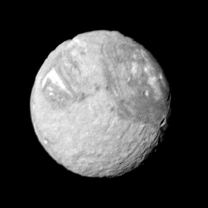William Herschel continued his career, building the largest telescopes of his age (of the reflecting kind--including the "Herschelian" design in which the observer, with his eyepiece, peeked down the telescope barrel from its top) and discovering two new moons of Saturn. His sister Caroline was not only a close helper but also an excellent astronomer in her own right, discovering many comets. His son John Frederick William Herschel was a famous astronomer, too, mapping the southern skies from the Cape of Good Hope, where he worked for many years.
Uranus is a gas giant (mostly hydrogen), with 27 known moons and thin rings, discovered by carefully tracking the brightness variation of a star passing behind them. We learned much more about it after Voyager 2 passed near it in 1986. It is a bland pale-blue sphere about 4 times the radius of Earth, with 14.5 times the mass and about 19 times the distance from the Sun, giving it an orbital period of 84 years. Its spin period (derived from Doppler shifts) is 17.2 hours and its "magnetic moment," the strength of its "equivalent central magnet" is about 50 times Earth's.
Both the Uranus rotation axis and its magnetic axis are unusual. The rotation axis is almost in the ecliptic--just 7 degrees off. Thus the thin rings can be almost perpendicular to the ecliptic, making it easier to observe their structure when a distant star passed behind them. In 1986 the axis pointed almost towards the Sun (a situation which occurs twice each orbit), making such observations convenient.
Because other planets with global magnetic field have the magnetic axis close to the rotation axis, the same was expected with Uranus, and scientists (including this one) wondered how the solar wind would deform a planetary magnetic field if it arrived not on the beam (as it does with Earth, Jupiter and Saturn) but almost from the pole. But it did not turn out that way. Instead, the magnetic axis makes a 59° angle with the rotation axis, causing it to travel rapidly around a cone ("precess"). Still, Uranus manages to keep a trapped radiation intensity comparable to the one near Saturn.
The 4 main moons of Uranus have radii between 500 and 800 km. The two biggest ones, Titania and Oberon, were discovered by Herschel in 1787 and are named after character's in Shakespeare's "Midsummer Night's Dream." The next two are Ariel and Umbriel, discovered by William Lassell in 1851 and given names from Alexander Pope's "Rape of the Lock". Other moons, where named, also take their names from works by these two authors.
 Best known among them is Miranda (radius 236 km), discovered in 1948 by the Belgian astronomer Gerard Kuiper, barely visible from Earth because it is so close to the planet, only 1/3 the distance of our Moon.
Best known among them is Miranda (radius 236 km), discovered in 1948 by the Belgian astronomer Gerard Kuiper, barely visible from Earth because it is so close to the planet, only 1/3 the distance of our Moon.
The name was suggested by "Ariel," which is also the name of a magical spirit which, together with Miranda, her father Prospero and near-human Caliban, inhabits an island in Shakespeare's "The Tempest" (two small moons were later named for Prospero and Caliban, too). Miranda is the one who, seeing a (shipwrecked) young man for the first time, exclaims "What brave new world is this with such creatures in it!" (brave here means "excellent"). Voyager 2 showed this to be a good description for the moon Miranda, too.
Voyager had to pass very close to Uranus for the gravity-assist encounter needed to reach Neptune, its next destination. Thus it came rather close to Miranda, and imaged it with great resolution. It is an icy moon, barely denser than water, and its surface turned out (in addition to its impact craters) to be sculptured, streaked and broken up, as if it had undergone some violent upheaval. Various explanations have been suggested, but all we have are those images from a one-time pass. Perhaps, the way Jupiter's Io is heated by tidal forces, Miranda too was in the past deformed by Ariel and Umbriel, heating it and squeezing out some of the icy interior.
|
 In the 1700s, the German city-state of Hanover was part of the domain of the British king. Friedrich Wilhelm Herschel was a musician in a Hanover regiment posted in Britain, where he quickly learned English, became Frederick William Herschel and entered a successful career in music.
In the 1700s, the German city-state of Hanover was part of the domain of the British king. Friedrich Wilhelm Herschel was a musician in a Hanover regiment posted in Britain, where he quickly learned English, became Frederick William Herschel and entered a successful career in music.
 Best known among them is Miranda (radius 236 km), discovered in 1948 by the Belgian astronomer Gerard Kuiper, barely visible from Earth because it is so close to the planet, only 1/3 the distance of our Moon.
Best known among them is Miranda (radius 236 km), discovered in 1948 by the Belgian astronomer Gerard Kuiper, barely visible from Earth because it is so close to the planet, only 1/3 the distance of our Moon.